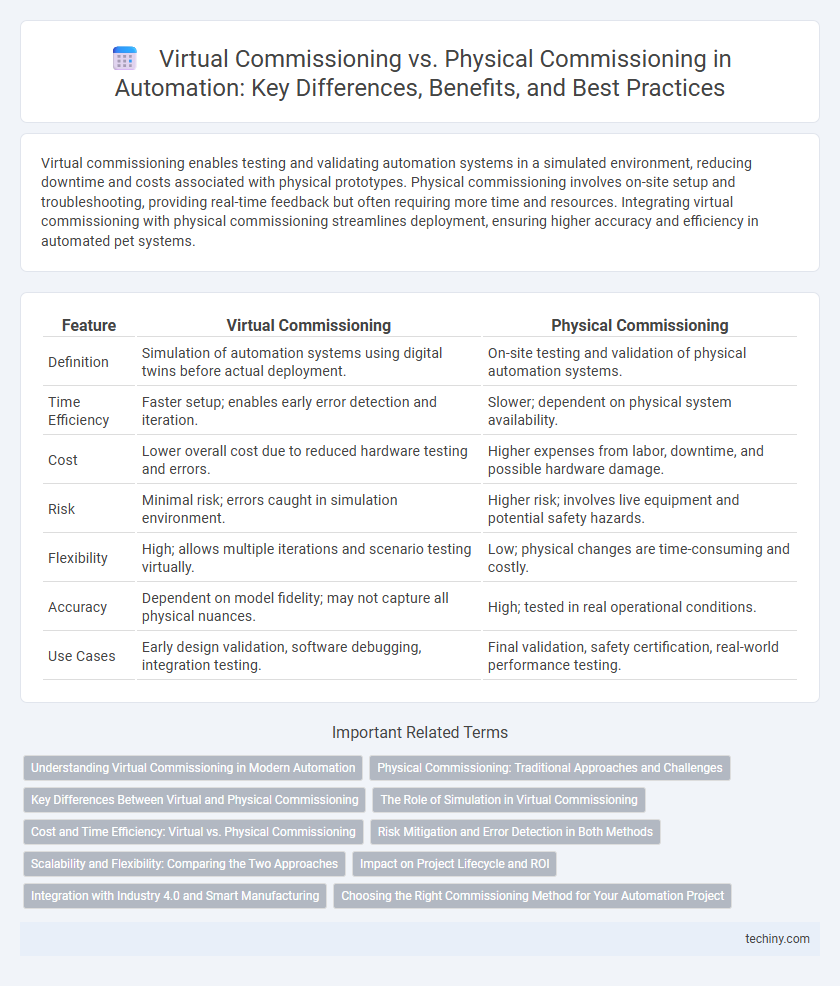Virtual commissioning enables testing and validating automation systems in a simulated environment, reducing downtime and costs associated with physical prototypes. Physical commissioning involves on-site setup and troubleshooting, providing real-time feedback but often requiring more time and resources. Integrating virtual commissioning with physical commissioning streamlines deployment, ensuring higher accuracy and efficiency in automated pet systems.
Table of Comparison
| Feature | Virtual Commissioning | Physical Commissioning |
|---|---|---|
| Definition | Simulation of automation systems using digital twins before actual deployment. | On-site testing and validation of physical automation systems. |
| Time Efficiency | Faster setup; enables early error detection and iteration. | Slower; dependent on physical system availability. |
| Cost | Lower overall cost due to reduced hardware testing and errors. | Higher expenses from labor, downtime, and possible hardware damage. |
| Risk | Minimal risk; errors caught in simulation environment. | Higher risk; involves live equipment and potential safety hazards. |
| Flexibility | High; allows multiple iterations and scenario testing virtually. | Low; physical changes are time-consuming and costly. |
| Accuracy | Dependent on model fidelity; may not capture all physical nuances. | High; tested in real operational conditions. |
| Use Cases | Early design validation, software debugging, integration testing. | Final validation, safety certification, real-world performance testing. |
Understanding Virtual Commissioning in Modern Automation
Virtual commissioning leverages digital twins and simulation software to validate and optimize automation systems before physical deployment, reducing costly errors and downtime. By replicating the entire production line in a virtual environment, engineers can detect and resolve issues faster and improve system integration. This method accelerates project timelines and enhances operational efficiency compared to traditional physical commissioning processes.
Physical Commissioning: Traditional Approaches and Challenges
Physical commissioning involves the hands-on testing and validation of automated systems on-site, using actual equipment and components to ensure proper functionality. Traditional approaches often face challenges such as high downtime, increased costs, and safety risks due to the need for manual adjustments and troubleshooting in real-time environments. These limitations highlight the need for more efficient and safe commissioning methods in industrial automation processes.
Key Differences Between Virtual and Physical Commissioning
Virtual commissioning leverages digital twin technology to simulate, test, and optimize automation systems in a virtual environment before deploying physical equipment. Physical commissioning involves on-site testing and adjustment of machinery, requiring actual hardware and more time-consuming troubleshooting processes. Key differences include reduced risk, cost savings, and faster iterations in virtual commissioning compared to the hands-on, real-world validation of physical commissioning.
The Role of Simulation in Virtual Commissioning
Simulation in virtual commissioning enables accurate virtual testing of automation systems before physical deployment, significantly reducing errors and system downtime. By replicating real-world conditions and system behaviors, simulation facilitates early detection of design flaws, optimizing control logic and integration processes. This proactive approach enhances project efficiency, lowers costs, and accelerates time-to-market compared to traditional physical commissioning.
Cost and Time Efficiency: Virtual vs. Physical Commissioning
Virtual commissioning significantly reduces project costs and accelerates timelines by enabling system testing and validation in a digital environment before physical deployment. Physical commissioning requires on-site resources, machinery downtime, and potential rework, leading to higher expenses and extended schedules. The cost effectiveness and time efficiency of virtual commissioning streamline automation projects by identifying errors early and minimizing production disruptions.
Risk Mitigation and Error Detection in Both Methods
Virtual commissioning leverages digital twin technology to simulate and validate automation systems before physical implementation, significantly reducing risk by identifying errors early in the design phase. Physical commissioning, while essential for real-world validation, carries higher risks due to potential equipment damage, production delays, and safety hazards during on-site testing. Integrating virtual commissioning with traditional physical commissioning maximizes error detection and mitigates risks, ensuring smoother, cost-effective system deployment and enhanced operational reliability.
Scalability and Flexibility: Comparing the Two Approaches
Virtual commissioning offers superior scalability by enabling simultaneous testing of multiple system configurations in a digital environment, reducing downtime and resource consumption. Physical commissioning, while providing real-world validation, often lacks the flexibility to quickly adapt to design changes or test varied scenarios without significant cost and time investments. The flexibility of virtual commissioning supports iterative development and rapid optimization, making it ideal for complex automation projects requiring frequent adjustments.
Impact on Project Lifecycle and ROI
Virtual commissioning accelerates the project lifecycle by enabling early detection and correction of design flaws through simulation, reducing downtime and costly rework during physical setup. Physical commissioning, while essential for validating real-world performance, often extends timelines due to on-site adjustments and integration challenges, impacting overall ROI negatively. Implementing virtual commissioning can improve ROI by minimizing project delays, reducing labor costs, and shortening time-to-market for automated systems.
Integration with Industry 4.0 and Smart Manufacturing
Virtual commissioning enables seamless integration with Industry 4.0 by simulating and validating automation systems digitally before physical deployment, reducing errors and downtime. It supports smart manufacturing through real-time data analysis, adaptive control strategies, and enhanced collaboration between IoT devices and digital twins. In contrast, physical commissioning requires manual testing on-site, which is time-consuming and less flexible in accommodating the dynamic demands of interconnected smart factories.
Choosing the Right Commissioning Method for Your Automation Project
Virtual commissioning accelerates automation project timelines by enabling thorough testing and optimization in a simulated environment before physical setup, reducing risks and costs. Physical commissioning provides hands-on verification and real-world adjustments to ensure system reliability and performance under actual operating conditions. Selecting the right commissioning method depends on project complexity, budget constraints, and the need for early fault detection versus practical validation.
Virtual Commissioning vs Physical Commissioning Infographic

 techiny.com
techiny.com